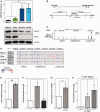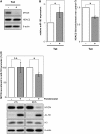MYCN and HDAC2 cooperate to repress miR-183 signaling in neuroblastoma
- PMID: 23625969
- PMCID: PMC3695529
- DOI: 10.1093/nar/gkt346
MYCN and HDAC2 cooperate to repress miR-183 signaling in neuroblastoma
Abstract
MYCN is a master regulator controlling many processes necessary for tumor cell survival. Here, we unravel a microRNA network that causes tumor suppressive effects in MYCN-amplified neuroblastoma cells. In profiling studies, histone deacetylase (HDAC) inhibitor treatment most strongly induced miR-183. Enforced miR-183 expression triggered apoptosis, and inhibited anchorage-independent colony formation in vitro and xenograft growth in mice. Furthermore, the mechanism of miR-183 induction was found to contribute to the cell death phenotype induced by HDAC inhibitors. Experiments to identify the HDAC(s) involved in miR-183 transcriptional regulation showed that HDAC2 depletion induced miR-183. HDAC2 overexpression reduced miR-183 levels and counteracted the induction caused by HDAC2 depletion or HDAC inhibitor treatment. MYCN was found to recruit HDAC2 in the same complexes to the miR-183 promoter, and HDAC2 depletion enhanced promoter-associated histone H4 pan-acetylation, suggesting epigenetic changes preceded transcriptional activation. These data reveal miR-183 tumor suppressive properties in neuroblastoma that are jointly repressed by MYCN and HDAC2, and suggest a novel way to bypass MYCN function.
Figures







Similar articles
-
GRHL1 acts as tumor suppressor in neuroblastoma and is negatively regulated by MYCN and HDAC3.Cancer Res. 2014 May 1;74(9):2604-16. doi: 10.1158/0008-5472.CAN-13-1904. Epub 2014 Jan 13. Cancer Res. 2014. PMID: 24419085
-
Biological effects of induced MYCN hyper-expression in MYCN-amplified neuroblastomas.Int J Oncol. 2010 Oct;37(4):983-91. doi: 10.3892/ijo_00000749. Int J Oncol. 2010. PMID: 20811720 Free PMC article.
-
MYCN-regulated microRNAs repress estrogen receptor-alpha (ESR1) expression and neuronal differentiation in human neuroblastoma.Proc Natl Acad Sci U S A. 2010 Jan 26;107(4):1553-8. doi: 10.1073/pnas.0913517107. Epub 2010 Jan 4. Proc Natl Acad Sci U S A. 2010. PMID: 20080637 Free PMC article.
-
A genome-wide search for promoters that respond to increased MYCN reveals both new oncogenic and tumor suppressor microRNAs associated with aggressive neuroblastoma.Cancer Res. 2011 Jun 1;71(11):3841-51. doi: 10.1158/0008-5472.CAN-10-4391. Epub 2011 Apr 15. Cancer Res. 2011. PMID: 21498633
-
MicroRNA involvement in the pathogenesis of neuroblastoma: potential for microRNA mediated therapeutics.Curr Pharm Des. 2009;15(4):456-62. doi: 10.2174/138161209787315837. Curr Pharm Des. 2009. PMID: 19199973 Free PMC article. Review.
Cited by
-
MicroRNA-183 in Cancer Progression.J Cancer. 2020 Jan 1;11(6):1315-1324. doi: 10.7150/jca.39044. eCollection 2020. J Cancer. 2020. PMID: 32047538 Free PMC article. Review.
-
HDAC2 enhances esophageal squamous cell carcinoma development through down-regulating microRNA-503-5p and promoting CXCL10.Clin Epigenetics. 2021 Apr 29;13(1):96. doi: 10.1186/s13148-021-01068-8. Clin Epigenetics. 2021. PMID: 33926524 Free PMC article.
-
Unveiling MYCN regulatory networks in neuroblastoma via integrative analysis of heterogeneous genomics data.Oncotarget. 2016 Jun 14;7(24):36293-36310. doi: 10.18632/oncotarget.9202. Oncotarget. 2016. PMID: 27167114 Free PMC article.
-
MYCN and HDAC5 transcriptionally repress CD9 to trigger invasion and metastasis in neuroblastoma.Oncotarget. 2016 Oct 11;7(41):66344-66359. doi: 10.18632/oncotarget.11662. Oncotarget. 2016. PMID: 27572323 Free PMC article.
-
Viral Ubiquitin Ligase Stimulates Selective Host MicroRNA Expression by Targeting ZEB Transcriptional Repressors.Viruses. 2017 Aug 7;9(8):210. doi: 10.3390/v9080210. Viruses. 2017. PMID: 28783105 Free PMC article.
References
-
- Brodeur GM. Neuroblastoma: biological insights into a clinical enigma. Nat. Rev. Cancer. 2003;3:203–216. - PubMed
-
- Schwab M, Westermann F, Hero B, Berthold F. Neuroblastoma: biology and molecular and chromosomal pathology. Lancet Oncol. 2003;4:472–480. - PubMed
-
- Westermark UK, Wilhelm M, Frenzel A, Henriksson MA. The MYCN oncogene and differentiation in neuroblastoma. Semin. Cancer Biol. 2011;21:256–266. - PubMed
-
- Bartel DP. MicroRNAs: genomics, biogenesis, mechanism, and function. Cell. 2004;116:281–297. - PubMed
Publication types
MeSH terms
Substances
Associated data
- Actions
LinkOut - more resources
Full Text Sources
Other Literature Sources
Medical
Molecular Biology Databases

